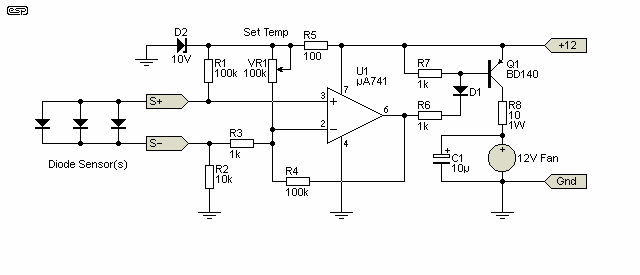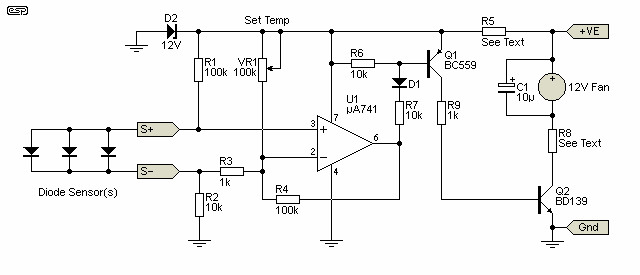

|
| Elliott Sound Products | Project 42 |
In many areas of the world, keeping an amplifier cool is no big deal because of generally low average temperatures. In Sydney (Australia), we can guarantee at least a few days every year when the temperature will be over 40°C, and we are not alone in this. With Global Warming/ Climate Change, we might all have the same problem in a few years.
The project described is not intended to allow you to skimp on the heatsink, but to ensure that the amp is never allowed to exceed a preset temperature. Class-A amplifiers and very high power amps will benefit the most, but the thermal controller principle described can be applied to almost anything.
It is extremely sensitive, and can easily be set so that a few degrees change is enough to turn on a fan, and reduce the power (or turn it off again) as the amp cools.
There is also a second version, designed to operate directly from the amp's +ve supply rail. It is specifically for amps that use a supply voltage greater than 30V. The circuit is almost identical, using one additional low cost transistor and an extra resistor. Diodes have a 'typical' temperature coefficient of -2mV/°C, but this changes with forward current and it isn't a linear function. In this application we don't care too much, as the circuit is adjustable. I suggest that 'standard' diodes be used, as there is no requirement for high speed or extreme accuracy.
The controller uses one or more ordinary silicon diodes as a sensor, and uses a cheap opamp as the amplifier. I designed this circuit to use 12V computer fans, as these are very easy to get cheaply. These fans typically draw about 200mA when running, so a small power transistor will be fine as the switch. I used a BD140 (1A, 6.5W), but almost anything similar that you have to hand will work just as well.

Figure 1 - The Thermo-Fan Controller
As can be seen, the circuit is very simple, and needs only a 12V single supply. This can be obtained from a small transformer, which need be rated at no more than 5VA or so. The supply does require regulation for the sensor if you want it to be accurate, but a simple zener regulator is sufficient for normal operation.
All diodes are 1N4004 or similar, and Q1 must be on a small heatsink - or may be mounted to the amplifier chassis. Make sure it is properly insulated, and use thermal grease. Maximum dissipation will be about 2 W, but it will overheat very quickly if there is no heatsink.
R7 has been added to ensure that Q1 turns off when the opamp's output is high. Most opamps can't reach the supply rail, and the voltage is usually about 1V less than the +ve supply. Some opamps may have a lower maximum voltage, and R7 will ensure that Q1 can be turned off completely. The same change has been made to the alternative version shown below.
The temperature is set with VR1. Operate the amp until the normal temperature is reached, then adjust VR1 until the fan starts. Then back off very slowly until the fan stops again. Any increase over the normal temperature will start the fan, and promptly bring the temperature back down again.
You can test the circuit without the amp, using a diode (or diodes) out in the air. Adjust as above, then hold the diode between your fingers - the fan should start up almost immediately, and stop again when you release the diode. Just the heat from your fingers is enough to operate the circuit. I tested the circuit with 3 standard 1N4004 diodes in parallel, and even without device selection I could hold any one of them and make the fan start.
I do not recommend that this be used from any preamp supply, as the fan motor noise will almost certainly cause problems. For this reason, I also suggest that you keep the switching transistor and fan leads will away from signal circuits to prevent noise.
It will not matter if the voltage is a little higher than 12V, as the fan will work fine as long as voltage is kept below about 30V. If you have more than this, see the 'alternative version' below. Remember that the maximum recommended voltage for many opamps is around +30V, and this must not be exceeded. If the voltage is greater than 12V, R5 will also need to be changed. Use the formula shown below for R5.
If the voltage is less than 12V you may have real problems. Most 12V fans will not run at less than about 8V, so don't even attempt it. You might be able to use 5V fans, but these are usually only very small and do not provide much airflow. You also need an opamp that can operate at low voltages.
If the supply voltage is not 12V as indicated, the Figure 1 circuit can still be used as shown with supply voltages up to 30V (opamp dependent). You will need to check the current that your fan draws to calculate the resistance. Connect it to a 12V supply, and measure the current. Your supply voltage must be less than 30V unloaded, otherwise see Figure 2 below. Calculate the resistance of R8 with ...
R8 = ( +ve - 12 ) / I Where +ve is your supply voltage, and I is the measured fan current
Select the closest resistor value larger than calculated. You will also need to work out the power:
PR5 = (+ve - 12)² / R8
For example, if you have a 25V supply available, and your fan draws 200mA at 12V ...
R8 = ( 25 - 12 ) / 0.2 = 13 / 0.2 = 65 Ohms (use 68 Ohms)
PR8 = (25 - 12)² / R8 = 13² / 56 = 169 / 68 = 2.5 Watts (use 5W)
Now you can work out the value for R5 (1W will usually be OK here) - here, use the next smaller value if an odd resistor value is calculated. The zener current is nominally 20mA, so ...
R5 = ( +ve - 10 ) / 0.02 Where +ve is your supply voltage.
R5 = ( 25 - 10 ) / 0.02 = 15 / 0.02 = 750 Ohms (use 680 ohms)
PR5 = ( 25 - 10 )² / 680 = 15² / 680 = 0.33W (use 1W)
Having worked these out, you can adapt the circuit to any voltage, as long as it is at least 15V and less than 30V. For higher voltages, see the alternative version in Figure 2 (below).
If you just happen to have a regulated 12V supply handy, you can leave out the 10V zener diode, use a short circuit for R5, and use the circuit as is. If you want to make a power supply, have a look at Figure 3 in Project 38. Simply leave out the extra mains wiring, since it is not needed.
The version shown in Figure 2 is designed to work directly from the amplifier's main power supply, regardless of voltage (within limits of course). Only the +ve supply is used, but the slight imbalance will not cause any problems with a properly designed power supply. Note that the schematic has been changed so that R5 and R8 are in the same locations as they are in Figure 1. Note too that the zener voltage is increased to 12V, as many opamps won't operate with a lower supply voltage.
The circuit is almost identical to that above, but uses an additional transistor to level-shift the 12V rail (which again uses a simple zener regulator) to drive the switching transistor. The two transistor switch has a much higher gain than the circuit of Figure 1, so the fan will tend to be either on or off - the variable fan speed will only work over a very limited range. This is not a problem, it is just different.

Figure 2 - Amplifier Supply Powered Version
The values of the resistors are calculated much as before, and the formulae are shown below. Expect to use higher powered resistors, especially with high amplifier voltages. As before, the opamp and zener circuit needs at least 20mA (but preferably 30mA because the opamp is powered from the same supply) to operate properly, so R5 is worked out with ...
R5 = ( +ve - 12 ) / 0.03 where +ve is the amplifier supply voltage. For a 40V supply ...
R5 = ( 40 - 12 ) / 0.03
R5 = 28 / 0.03 = 840 (use 820 ohms)
Power rating is ...
P = V² / R = 28² / 820 = 0.96W A 1W resistor may appear sufficient, but it will run hot. Use 2W.
To work out the value and power rating of R9 (the fan series resistor), still with the 40V supply but using 2 fans in series, and running the fans at 10V each to keep them quiet ...
R8 = ( +ve - Vfan ) / 0.2 Where 0.2 is the measured fan current (same as above for version 1)
R8 = ( 40 - 20 ) / 0.2 = 20 / 0.2 = 100 Ohms
P = V2 / R = 400 / 100 = 4W so a 5W resistor will be fine (note that it will run very hot, so keep it away from anything that may melt!)
Any other combination is quite acceptable, including the use of fans in series/parallel (remember that the current will be double) or anything else that you might want to do. This is a very flexible circuit, and its use is only limited by imagination, as there are many other uses for a sensitive thermal controller.
Although I've shown the circuit using a µA741, most other low cost opamps will work just as well, including the TL071. Several CMOS types may also be suitable, but usually with a limited maximum supply voltage (which means that Version 2 should be used if the opamp is not rated for more than 12V). There's no reason to spend more than AU$1.00 ($2.00 maximum) for the opamp, depending on the supplier. The opamp must be able to work with a supply voltage of at least 12V, or several resistor values will need to be re-calculated.
 Main Index
Main Index
 Projects Index
Projects Index